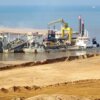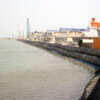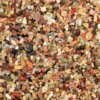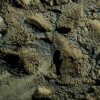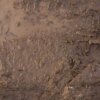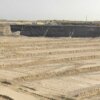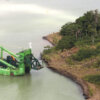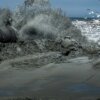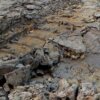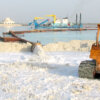The properties of carbonate sand are different than more commonly used quartz sands and its behaviour must be considered when using it for fill.
Since in certain parts of the world the only fill material available may be carbonate sand, its properties must be considered. These properties often deviate significantly from those of the more commonly used quartz sand and will therefore behave differently than quartz sand during and after the reclamation process.
Origin and composition of carbonate sands
Carbonate soils are defined as soils in which carbonate minerals predominate. They are widely distributed in the warm and shallow seas and oceans of the world’s tropical and subtropical regions, covering almost 40% of the ocean floor. Carbonate deposits are usually formed by accumulation of skeletal remains of small marine organisms, known as bioclastic deposits, or they may have a non-organic origin, for instance, as a result of chemical precipitation from carbonate-rich water known as oolites.
Unique post-depositional processes of cementation, dissolution, re-crystallisation and other diagenetic changes have produced various types of carbonate deposits with varying mechanical properties that may deviate significantly from those of the commonly known quartz sands. It is therefore important to properly classify the nature of the carbonate deposits in the borrow area and in the reclamation area (when applicable) in an early stage of the design.
The adjective “carbonate” is generally being used as a generic description of all sediments containing calcium or magnesium carbonate as follows:
- a sand classifies as a ‘carbonate’ sand when its carbonate content is in excess of 90%;
- a ‘siliceous carbonate’ sand has a carbonate content of 50 to 90%; and
- the adjective ‘calcareous’ is used for deposits with a carbonate content of 10-50%.
In practice, however, a less strict nomenclature is often used and both calcareous sand and carbonate sand are encountered in soil classification as a general description.
Deviating behaviour of carbonate sand
Site investigations and laboratory testing, design and subsequent technical specifications of a reclamation area filled with carbonate sand have to take the deviating behaviour of carbonate sand into account.
The typical performance of a carbonate sand fill is mostly a result of the crushability and angularity of the carbonate grains, the high initial void ratio of the carbonate fill mass after deposition, and the cementation between the particles. Issues may include:
- lower cone resistance and N-value (standard penetration test -SPT) than encountered in quartz sands at comparable stress levels and (relative) densities;
- degradation of the grain size distribution (increase fines content) during dredging, transport and deposition;
- results of laboratory tests that may fall outside the common range of test results of quartz sands;
- higher compressibility than quartz sands (at high stress levels);
- higher peak friction angle than quartz sands;
- higher resistance against cyclic loading than quartz sands at comparable stress levels and (relative) densities;
- possible lower productions of the dredger in the borrow area as a result of in-situ cementation; and
- increasing strength and stiffness of fill mass over time after deposition of the fill.



